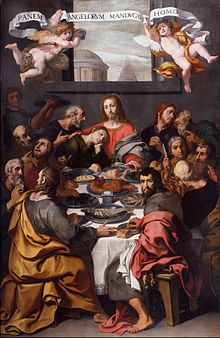
The Last Supper is the final meal that, in the Gospel accounts, Jesus shared with his apostles in Jerusalem before his crucifixion. The Last Supper is commemorated by Christians especially on Holy Thursday. The Last Supper provides the scriptural basis for the Eucharist, also known as "Holy Communion" or "The Lord's Supper".

The Last Supper is a mural painting by the Italian High Renaissance artist Leonardo da Vinci, dated to c. 1495–1498, housed in the refectory of the Convent of Santa Maria delle Grazie in Milan, Italy. The painting represents the scene of the Last Supper of Jesus with the Twelve Apostles, as it is told in the Gospel of John – specifically the moment after Jesus announces that one of his apostles will betray him. Its handling of space, mastery of perspective, treatment of motion and complex display of human emotion has made it one of the Western world's most recognizable paintings and among Leonardo's most celebrated works. Some commentators consider it pivotal in inaugurating the transition into what is now termed the High Renaissance.

Andrea del Castagno or Andrea di Bartolo di Bargilla was an Italian Renaissance painter in Florence, influenced chiefly by Masaccio and Giotto di Bondone. His works include frescoes in Sant'Apollonia in Florence and the painted equestrian monument of Niccolò da Tolentino (1456) in Florence Cathedral. He in turn influenced the Ferrarese school of Cosmè Tura, Francesco del Cossa and Ercole de' Roberti.

Paolo Caliari, known as Paolo Veronese, was an Italian Renaissance painter based in Venice, known for extremely large history paintings of religion and mythology, such as The Wedding at Cana (1563) and The Feast in the House of Levi (1573). Included with Titian, a generation older, and Tintoretto, a decade senior, Veronese is one of the "great trio that dominated Venetian painting of the cinquecento" and the Late Renaissance in the 16th century. Known as a supreme colorist, and after an early period with Mannerism, Paolo Veronese developed a naturalist style of painting, influenced by Titian.

Café Terrace at Night is an 1888 oil painting by the Dutch artist Vincent van Gogh. It is also known as The Cafe Terrace on the Place du Forum, and, when first exhibited in 1891, was entitled Coffeehouse, in the evening.

Jacopo Bassano, known also as Jacopo dal Ponte, was an Italian painter who was born and died in Bassano del Grappa near Venice, and took the village as his surname. Trained in the workshop of his father, Francesco the Elder, and studying under Bonifazio Veronese in Venice, he painted mostly religious paintings including landscape and genre scenes. He often treated biblical themes in the manner of rural genre scenes, portraying people who look like local peasants and depicting animals with real interest. Bassano's pictures were very popular in Venice because of their depiction of animals and nocturnal scenes. His four sons: Francesco Bassano the Younger, Giovanni Battista da Ponte, Leandro Bassano, and Girolamo da Ponte, also became artists and followed him closely in style and subject matter.

Supper at Emmaus (1606) is a painting by the Italian master Caravaggio, housed in the Pinacoteca di Brera, Milan.
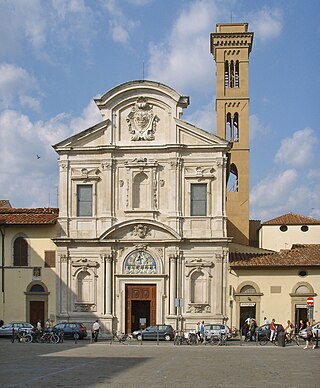
The chiesa di San Salvatore di Ognissanti, or more simply chiesa di Ognissanti, is a Franciscan church located on the piazza of the same name in central Florence, region of Tuscany, Italy. Founded by the lay order of the Umiliati, the church was dedicated to all the saints and martyrs, known and unknown.

Sister Plautilla Nelli (1524–1588) was a self-taught nun-artist and the first ever known female Renaissance painter of Florence. She was a nun of the Dominican convent of St. Catherine of Siena located in Piazza San Marco, Florence, and was heavily influenced by the teachings of Savonarola and by the artwork of Fra Bartolomeo.
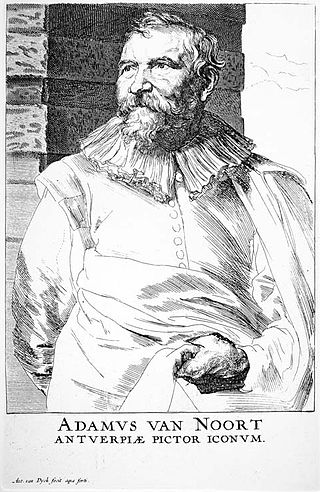
Adam van Noort was a Flemish painter and draughtsman and one of the teachers of Peter Paul Rubens, and the only teacher of Jacob Jordaens. Adam van Noort was mainly known for his history paintings but he also created some portraits. He was a designer for engravings for the Collaert family of printmakers and publishers.

The Sacrament of the Last Supper is a painting by Salvador Dalí. Completed in 1955, after nine months of work, it remains one of his most popular compositions. Since its arrival at the National Gallery of Art in Washington, D.C. in 1955, it replaced Renoir's A Girl with a Watering Can as the most popular piece in the museum.

The Last Supper of Jesus and the Twelve Apostles has been a popular subject in Christian art, often as part of a cycle showing the Life of Christ. Depictions of the Last Supper in Christian art date back to early Christianity and can be seen in the Catacombs of Rome.

The Last Supper (1493–1496) is a fresco by the Italian Renaissance painter Pietro Perugino, located in the refectory, now museum, of the former Convent of Fuligno located on Via Faenza #42 in Florence, region of Tuscany, Italy.

The Italian Renaissance painter Domenico Ghirlandaio painted the Last Supper of Jesus three times in separate fresco paintings in or near Florence. The oldest of the three is located in the Badia di Passignano (1476). The next painting is the most famous one, painted in the refectory of the Convent of the Ognissanti (1480). The last painting is found at the Convent of San Marco (1486). The last two paintings are found in Florence itself.

The Last Supper (1445–1450) is a fresco by the Italian Renaissance artist Andrea del Castagno, located in the refectory of the convent of Sant'Apollonia, now the Museo di Cenacolo di Sant'Apollonia, and accessed through a door on Via Ventisette Aprile at the corner with Santa Reparata, in Florence, region of Tuscany. The painting depicts Jesus and the Apostles during the Last Supper, with Judas, unlike all the other apostles, sitting separately on the near side of the table, as is common in depictions of the Last Supper in Christian art.
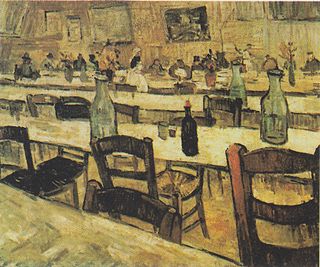
Interior of a Restaurant in Arles is a colored oil painting by Dutch artist Vincent van Gogh on an industrially primed canvas of size 25 (Toile de 25 figure) in Arles, France, late August, 1888.

Work on the conservation and restoration of Leonardo da Vinci's The Last Supper mural, much of it more harmful than helpful, has been carried out over many centuries, and continues. Completed in the late 15th century by the Renaissance artist Leonardo da Vinci, the mural is located in the refectory of the Convent of Santa Maria delle Grazie, Milan, Italy. The Last Supper was commissioned by Ludovico Sforza, Duke of Milan in 1495, as part of a series of renovations to the convent with the intention that the location would become the Sforza family mausoleum. Painting began in 1495 and continued until 1498.
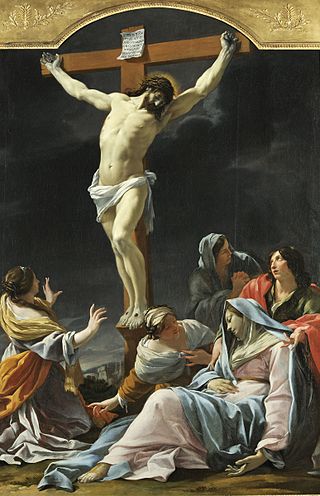
Crucifixion is an oil on canvas painting by Simon Vouet, executed in 1636-1627. This painting is part of a set of three works, together with the paintings representing the Last Supper and the incredulity of St. Thomas. It is now in the Museum of Fine Arts of Lyon.

Leonardo and the Last Supper, is a 2011 book written by Ross King, a Canadian novelist and non-fiction writer. He was awarded Canada's 2012 Governor General's Award for English-language non-fiction for Leonardo and the Last Supper, his examination of da Vinci's iconic 15th century religious mural.

The Last Supper is a tempera painting by Greek painter Michael Damaskinos. He painted in Heraklion, Sicily, Venice, and other parts of Italy. His painting of the Last Supper is considered the Greek Last Supper and is comparative to Leonardo da Vinci's masterpiece painted one hundred years prior. The two painters employed different painting styles but the subjects pose similarities. Damaskinos's painting features a feminine figure similar to that of Leonardo da Vinci's The Last Supper. The Damaskinos Last Supper is now in the Monastery of Agia Aikaterini in Heraklion, Crete. It is part of the collection of Saint Catherine's Monastery near Mount Sinai, Egypt.
